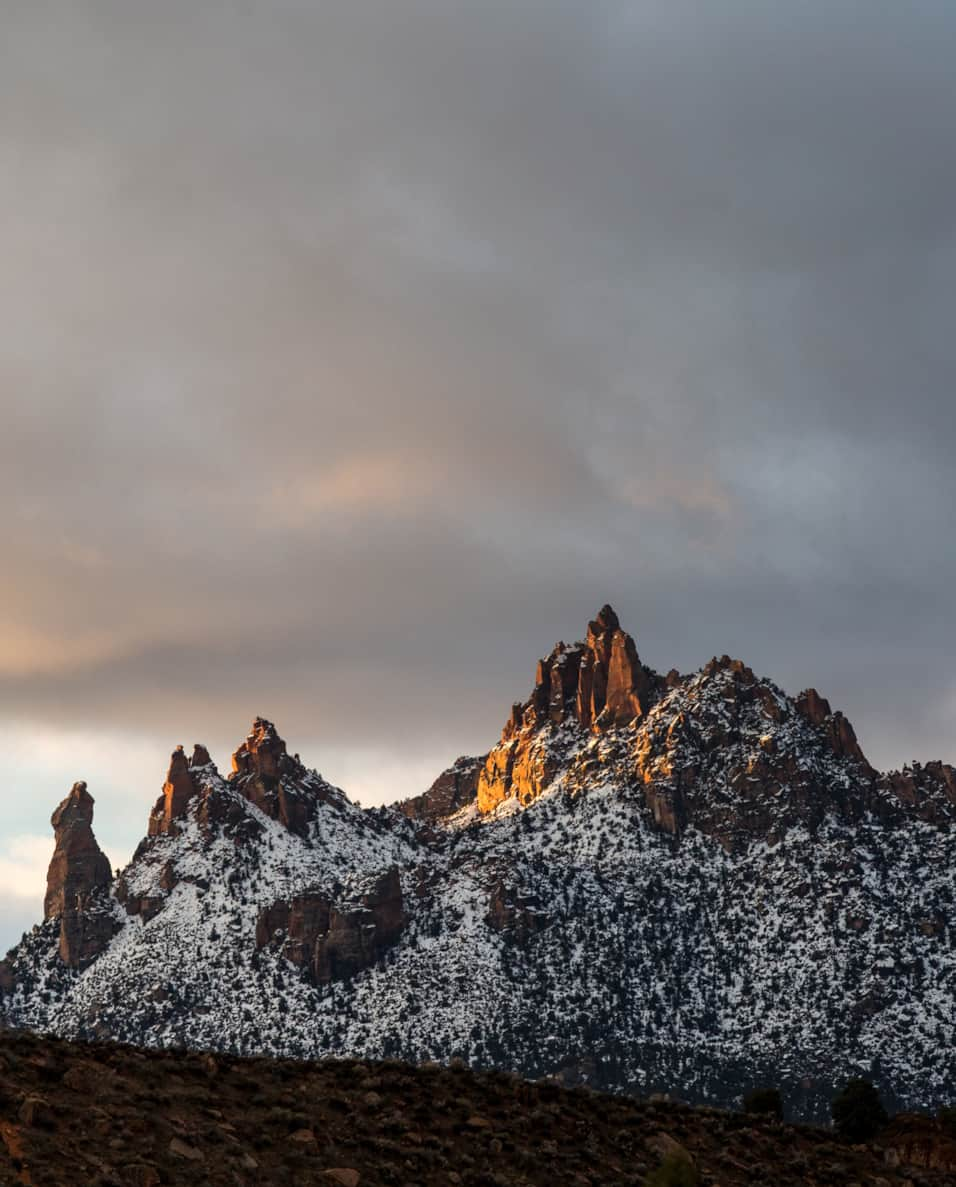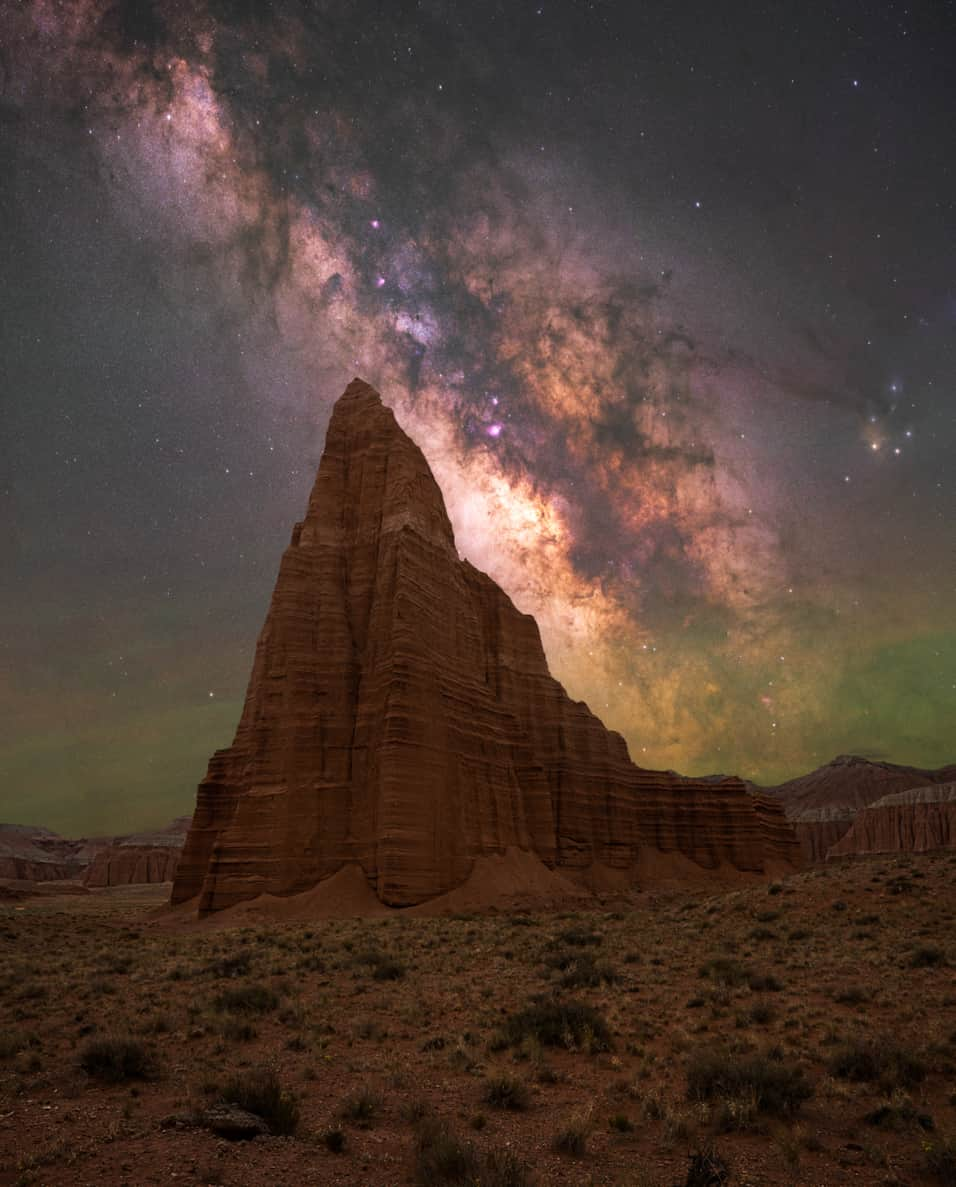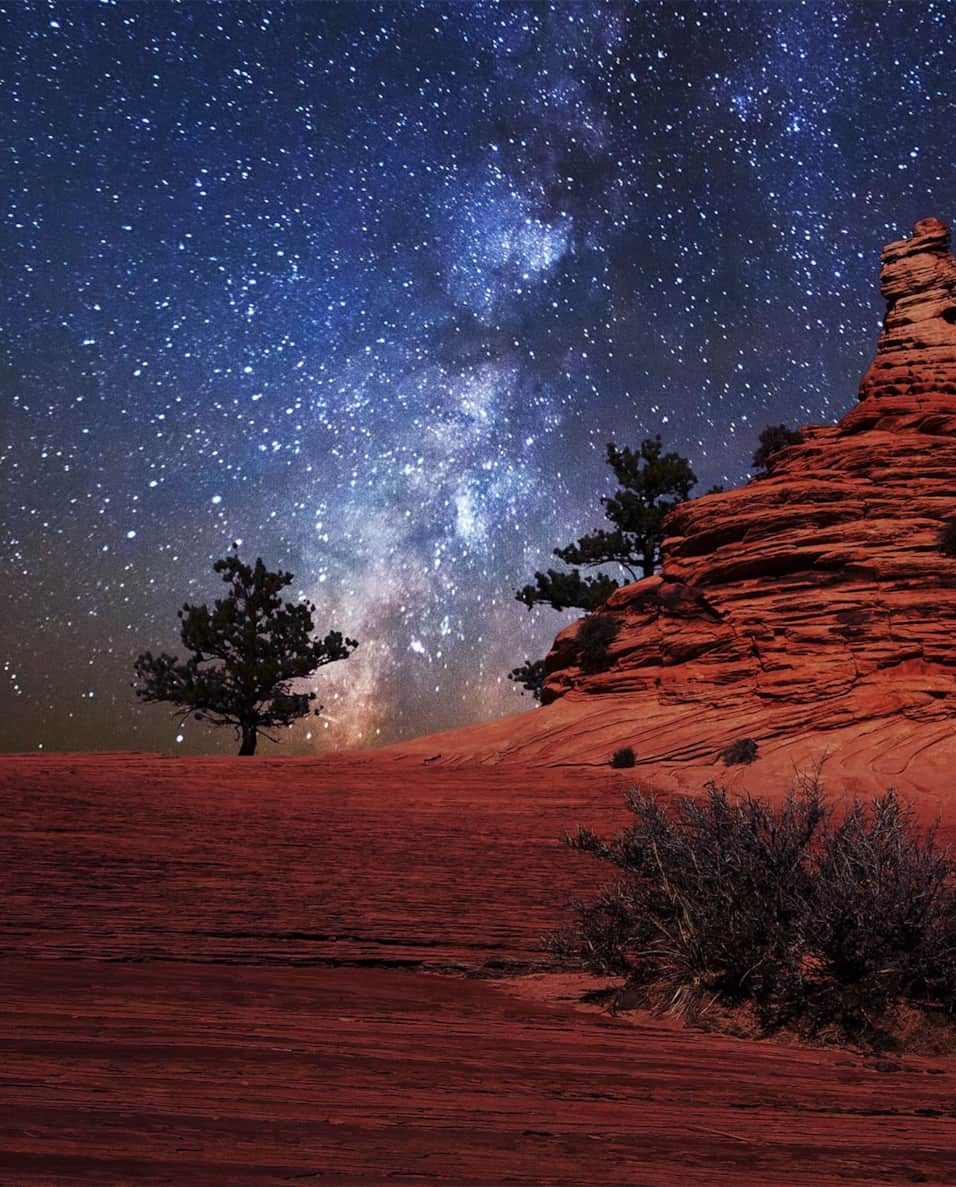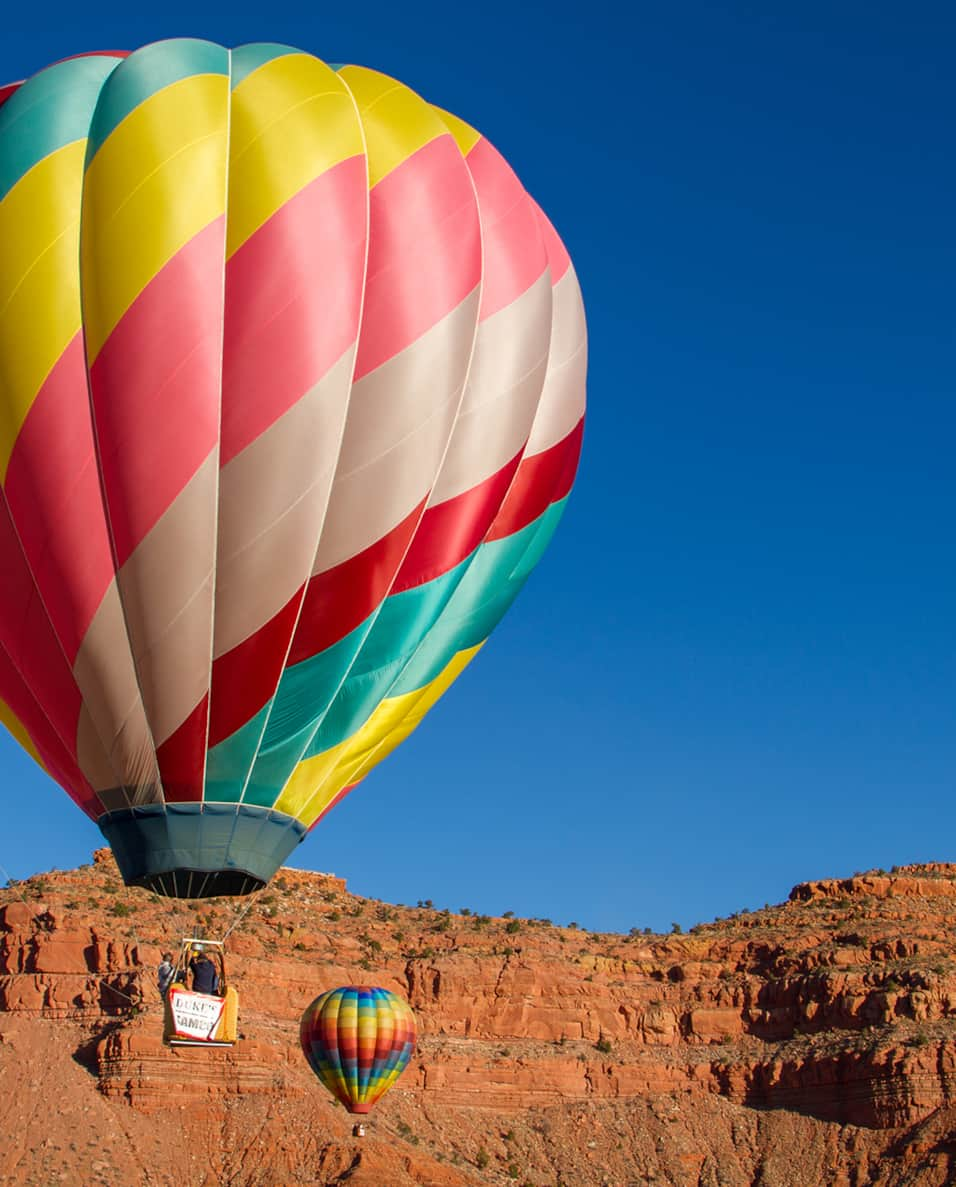Saddle Up for a Utah Cowboycation
Explore the cowboy way of life on a cattle drive and horseback riding adventure with The Ranch at Wild Rose in Southern Utah.
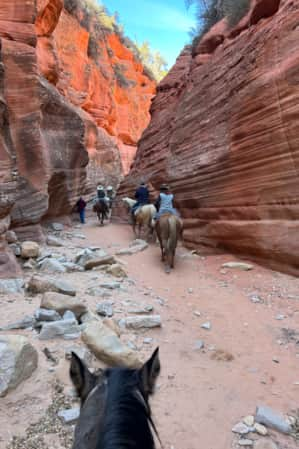
This isn’t a typical western riding resort vacation, but if you seek a total immersion experience on a real cattle drive, this is just the trip for you. Participants “push” the cattle from Southern Utah 110 miles to the north rim of the Grand Canyon. The trip, led by a professional ranching family and their friends, is a rugged adventure, with long days in the saddle and nights spent camping under the stars.
Your hosts, Harmony and Dustin Cox, and their six hard-working, hard-riding cowgirl daughters welcome you with open arms, anxious to share their heritage and ranching way of life. Harmony proudly recounted, “My second great-grandfather was an original settler in the area. In 1856, he, his wife, and their two babies traveled from England. They landed in Boston and took a train to Iowa to begin their trek to Utah with a pushcart for over 1,300 miles. There, they settled and worked the land to raise livestock.”
It has been standard practice since the early 1900s for livestock herds to travel over 100 miles between summer grazing areas in Utah to winter grazing in Arizona. Many of the highways today were livestock trails then. Holding onto the cattle-driving tradition and sharing the ranching lifestyle are Harmony and Dustin’s priorities and their joy.
The Ranch at Wild Rose is nestled between Zion and Bryce Canyon national parks. From the airport at St. George, it is an exceptionally scenic drive that takes you through the famous tunnel into Zion and quaint towns along the way. As you come up the ranch road past corrals and a barn, you come to the impressive lodge.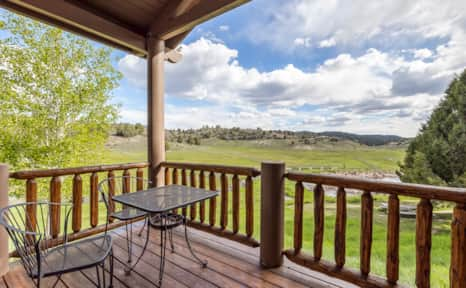
The property hosts weddings and other large events, and has plentiful modern lodging options for guests, all while continuing a tradition of raising livestock and cultivating the land.
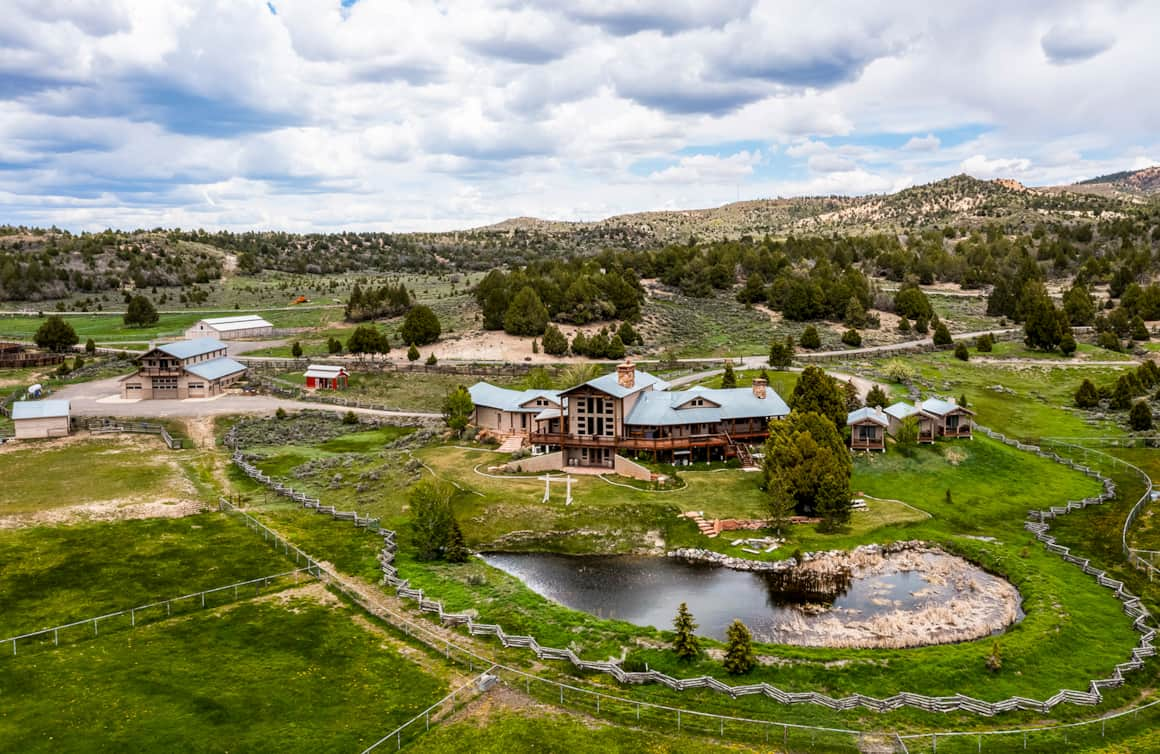
The Ranch at Wild Rose is situated on 180 acres of land in the mountains of Southern Utah.
Shortly after we arrived, we headed to the barn to meet and select our horses. Once our horses and tack were assigned, we took a brief test ride to determine our abilities. Dustin laid out a general plan for the days ahead.
Then, back up to the main lodge the week got its real start with an abundant dinner served family-style at a huge table set with beautifully western-themed accoutrements. Dinner featured Wild Rose beef, produce from Harmony’s sister’s garden, and pies still warm from baking by the daughters. Saying grace before the meals set the tone for the camaraderie of the week to come. During and after dinner we had a chance to connect with our group and to learn about each other.
Mornings began early in the kitchen for breakfast and making lunches to pack in our saddlebags to eat on the trail for our five-day drive. Horses were loaded onto trailers, and we piled into the trucks on our way to meet the cattle herd at the corral. Once the gate was opened, cows filtered steadily out, mooing as they went. The excitement in the air was palpable, especially from the horses and the two heeler dogs that were anxious to get going doing their jobs.
There were times when you felt like you were on a leisurely trail ride, and there just happen to be 800 cows coming with you. But just when you started to relax and take in the amazing scenery, something would disrupt the calm, and you would have to jump into action. It could be that a group of cows was starting to break off, so you’d need to head for the hills to trot above them and push them back down toward the herd; or the terrain might change drastically, and you’d need to pay attention to your track.
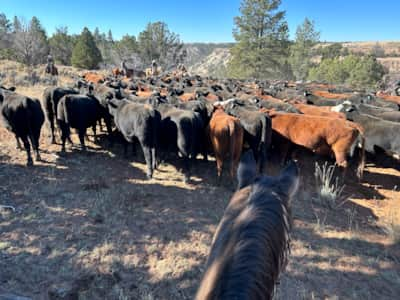
Navigating Juniper Mazes and Riverbed Rocks
The wonderful Quarter Horse I was on named “A Boy Named Sue” was extremely capable of picking his way through the juniper mazes or the rocks in the old riverbeds. Sometimes the sand would become quite deep and it would be harder for the cows and horses, but “Sue” would steadily make his way, stopping when he needed a rest, waiting for me to urge him forward again. Then, with a sigh, he’d pick up his ever-steady walk and carry on. He seemed to know he was going to be out there for a long day and how to pace himself. He knew which plants he preferred as we passed, and he would grab a bite for the road. It was exhilarating when there were drop-downs in the terrain (some not so little!) but Sue thought nothing of it. I began to trust him and would just grab the horn, kick my legs forward, lean back, and go for the ride. He clearly knew his job. I could watch him read the herd and feel him respond. Not knowing the rules of the game myself, I took a lot of cues and comfort from him.
Though we were given some brief instructions before we left, it took the first half day of closely observing the cowboys, watching the herd, reading the horse, and asking questions to finally see how things worked. Once I understood, it felt good to have a sense of purpose and to be able to assist in moving the herd along. A few times I would find myself out in the middle of nowhere with a bunch of stray cows trying to keep them in line. When I would need to call the cowboys for help, the wonderfully skilled young riders would come swooping down from the hillsides, whooping and hollering, making a smacking sound on their chaps with stiff ropes. The cows would instantly respond, hustling to get back in with the herd. The dogs kept the cows pace working them from behind.
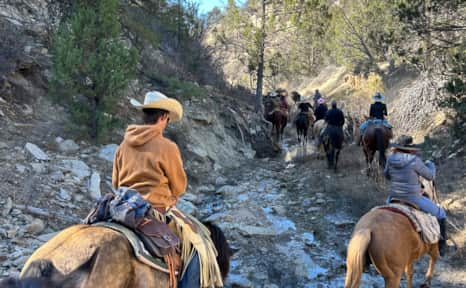
The summer cattle drive takes cattle to the high elevations near Bryce Canyon National Park.
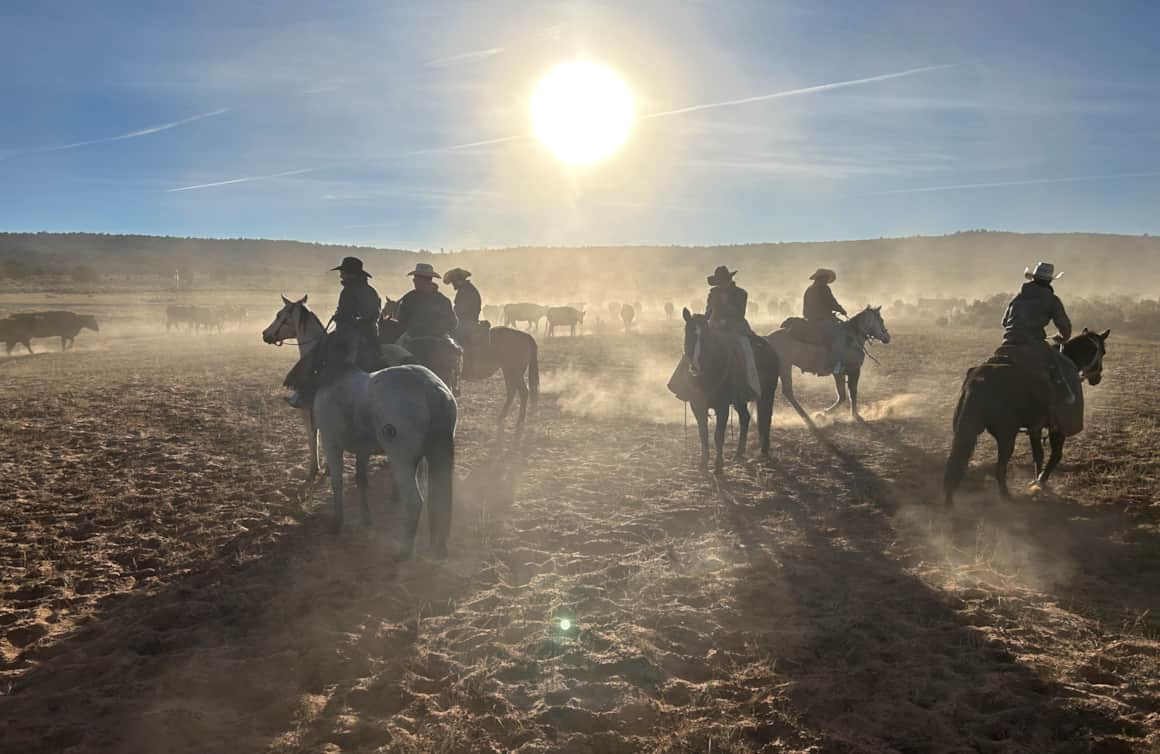
A first time on a horse may be intimidating and unnatural to most, but over the few days of the cattle drive, timidness sheds and a bond of trust is formed.
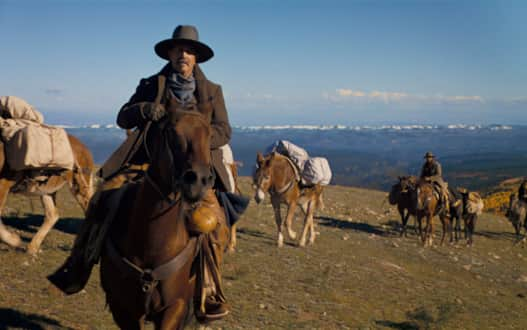
Horizon: An American Saga –– Chapter 1 © 2024 Warner Bros. Ent. All Rights Reserved. Rated R.
Photo: Richard Foreman/Warner Bros. Pictures
Journey Through Utah's Iconic Western Film Settings
When you picture the American West, chances are you are picturing Utah. So it’s no surprise that Hollywood has relied on the state’s remarkable scenery for more than a 100 years, most recently in Kevin Costner’s epic western, “Horizon: An American Saga.” Filmed in the La Sal Mountains near Moab, along the San Rafael River in Emery County, Warner Valley in Washington County and other locations, “Horizon: An American Saga” is a multi-faceted chronicle covering the Civil War expansion and settlement of the American West. And Utah’s landscapes play no minor role. You can bring your favorite movie scenes to life when you make a stop at these and other iconic film locations.
A Special Breed of Horses
One of my favorite things about the trip was watching the cowboys ride and handle their horses. They are all friends or family that have grown up (or are growing up) together and embrace the lifestyle. Some started their careers as toddlers on the back of the horses behind their parents, holding on tightly, happy to be part of the action. Our youngest cowgirl on this trip was just turning four. As the star of the show, she never tired and would have been devastated to be left behind. She would occasionally swap mounts and be tossed through the air to land behind the saddle to ride with a different parent or sister. By the end of the third day, she proudly rode independently in a miniature western saddle. “I’m riding by myself!” she proudly declared.
The horses on this trip are most definitely a special breed, completely different from the show horses I’m accustomed to. I and my equestrian friend who joined me on the trip often commented, “There is no way our horses could do this job, physically or mentally!” The ranch horses’ conformation is different than that of our warmbloods, and it was fun to watch them use their bodies to navigate the tough terrain. They climb up and down steep slopes and have an impressive ability to turn on their haunches. Most of the horses come from local ranchers who have bred and raised them. They’re bred for stamina, strength, and temperament. The horses are trained on the job. Many of the boys were on younger horses, and explained to us that the cattle drive was a good way to start them because they learned from the other experienced horses and were easier to train when they were a little tired.
It was not unusual to see a cowboy leading a younger horse while they worked or a loose colt following his mom, learning footwork and how to negotiate the different terrains. It was evident how cherished the horses were—the cowboys spoke of them with great pride. Some of the young cowboys shared stories of their rodeo and team-penning work, one having earned a scholarship to college from his rodeo accomplishments. The logistics of the drive were daunting. Trucks and trailers would drive to camp to meet us and swap out horses. There was a constant rotation, so no horse was overworked by our 10-to 12-miles a day. If there is no water in the creeks along the way, enormous plastic troughs are shipped with the hay, followed by a tanker of water. This is one of the few times when it was possible to dismount, stretch, and grab your pre-packed lunch. You snack and drink along the way with whatever you’ve packed in your saddlebag that morning and hop off quickly to find a tree to “talk to a man about a horse” if nature calls.
"The last night was bittersweet, as our trail boss thanked us for coming and noted, 'We have come as strangers and are leaving as friends.'"
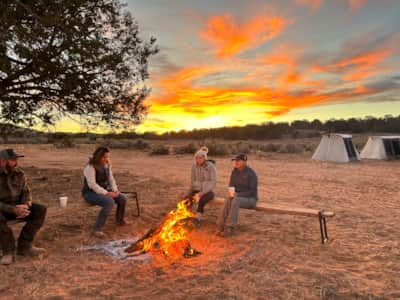
Swapping Stories by the Campfire
At each station, the herd was pushed into a corral and counted. Depending on the day, what follows varied. The first day we untacked, hung saddles on sturdier limbs, and tied the horses to trees by a big pile of home-grown alfalfa hay. Then, we took off on four-wheelers for a wild ride through the dunes to get to camp. Camp was an experience of its own. Everything is waiting in place when you arrive. There is a circle of two-person tents outfitted with padded cots, warm bed rolls, lanterns, and heaters. Port-a-johns, a dinner tent, and a campfire made up the rest of the scene.
After dinner the first night, we were presented with well-earned “Wild Rags,” a Wild Rose tradition of colorful bandanas to wear for the rest of the trip to protect from dust and keep necks warm. Each day’s drive became more familiar to all of us; we shared our early morning coffees in the pre-dawn mist and loaded our packs before we set off for the day’s adventure.
Before heading to the tents, in the evening we gathered around the campfire to share stories of the day. The cowboys were full of questions for guests. They were interested in where we came from and what it was like for us at home. They seemed truly happy to meet people with different lifestyles and share their own.
The last night was bittersweet, as our trail boss thanked us for coming and noted, “We have come as strangers and are leaving as friends.”
Wild Rose offers a variety of cowboy experiences from day trips to 10 days and in between. You can also join them for a day of calving or branding. Ranch weddings or overnight stays can also be arranged.
If going on a cattle drive is on your bucket list — then it’s time to saddle up.
This story originally appeared in Equestrian Living magazine.
What's Nearby
-
Zion National Park
Whether you are trying to catch your breath while climbing the trail to Angel's Landing or watching the shadows constantly change the mood of the Court of the Patriarchs, Zion National Park is always ready to quench your appetite for outdoor wonder.
-
Grand Staircase–Escalante National Monument
Grand Staircase-Escalante is a vast and rugged, yet easily accessible national monument.
-
Cedar Breaks National Monument
Cedar Breaks National Monument, 23 miles east of Cedar City, offers a stunning red rock amphitheater, scenic hiking and exceptional stargazing.
-
Bryce Canyon National Park
An alpine forest with as many red rock hoodoos as trees. At dawn and dusk, mule deer graze the forested plateau along the road into Bryce Canyon.
-
Dixie National Forest
This forest stretches for 170 miles across southern Utah. Visitors can experience its brilliant red spires and cliffs by car or by hiking one of the nature trails in the canyon.
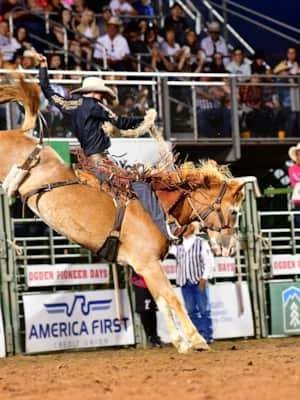
Utah Rodeo Round-Up
From its vast landscapes to its iconic cowboy traditions, Utah perfectly embodies the spirit of the American West. Join us this summer at a local rodeo to enjoy impressive horsemanship and a vibrant, family-friendly celebration of this timeless culture.



